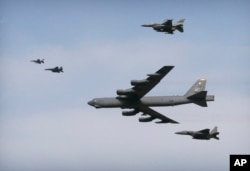At Sandia National Laboratories inside Kirtland Air Force Base, nuclear weapons equipment is spun around, smashed and even blown up--all to help the U.S. military modernize its nuclear weapons stockpile.
Nuclear weapons are essential for US defense
Speaking at the base Tuesday, U.S. Secretary of Defense Ash Carter told troops that the nuclear mission is the “bedrock of American security.”
The U.S. can deter a nuclear attack in three ways: by land with intercontinental ballistic missiles, by air with nuclear weapons on bombers and fighter jets, and by sea with nuclear missiles roaming the oceans on submarines. These methods are more commonly known as the “nuclear triad.”
Update is necessary
But all of the programs are entering an age where they need to be modernized.
The last B-52H bomber aircraft rolled off the production line in 1952. New B61-12 nuclear bombs currently being developed at Sandia are updating tube technology dating back several decades, but they won’t be ready until 2020.
Outdated computer systems
William Schneider, President of International Planning Services and Former Under Secretary of State for Security Assistance, Science and Technology, says the expansive land-based Minuteman III Intercontinental Ballistic Missiles (ICBMs) system was produced in the 1970s and is in need of a complete makeover.
“As a benchmark of their ancient character, they still use floppy disks and computers that would be relics in any other setting apart from this,” Schneider told VOA.
And the most survivable leg of the nuclear triad, the Ohio-class submarine, has had its life extended from 30 years to 42 years and will start to age out in the next decade.
Wars in Iraq and Afghanistan took attention away
Years of underfunding and a lack of attention have raised questions about how reliable and safe the United States’ most dangerous weapon will be if more action is not taken soon.
“If we’re going to maintain a safe, secure, and effective force, we’re going to need to do something to replace the existing delivery systems and extend the life of the nuclear weapons that we have,” Frank Klotz, the U.S. Under Secretary of Energy for Nuclear Security, said at a recent nuclear talk hosted by the Council on Foreign Relations.
While in New Mexico, Carter echoed the need to modernize all three legs of the triad and placed the blame for years of delay on being “preoccupied” in wars in Iraq and Afghanistan, which he called “understandable.”
US trailing Russia and China
The delay has put the U.S. nuclear modernization program 20 years behind the Chinese and Russian modernization programs, according to Schneider.
“That in itself is a source of instability and something that we need to correct,” he said.
The U.S. military's top deterrent is up for a $108 billion makeover planned over the next five years. However, budget squabbles in Congress have continued to threaten the stability of future modernization plans.
